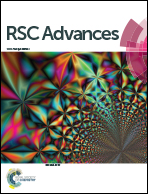Luminescence properties and Judd–Ofelt analysis of TiO2:Eu3+ nanofibers via polymer-based electrospinning method
Abstract
One-dimensional TiO2:xEu3+ nanofibers were fabricated via electrospinning and subsequent calcination. The as-spun nanofibers were calcined at 600, 700, 800 and 900 °C for 5 h at a heating rate of 1 °C min−1 and the concentrations of Eu3+ dopants were varied from 17 mol% to 20 mol%. The TiO2:19 mol% Eu3+ nanofibers which calcined at 700 °C (optimum condition) were investigated by thermogravimetric-differential thermal analysis (TG-DTA), X-ray diffraction (XRD), X-ray photo-electronic spectroscopy (XPS), scanning electron microscopy (SEM), Fourier transform infrared spectroscopy (FT-IR), UV-vis diffuse reflectance spectroscopy (UV-vis DRS), photoluminescence (PL) excitation and emission spectra. In this article, we have discussed the effect of different calcination temperature on fiber diameter and photoluminescence properties of europium doped titania (TiO2:xEu3+) nanofibers. The possible formation mechanism of TiO2:x mol% Eu3+ nanofibers was also discussed. The spectral characteristics and Eu–O ligand behavior were discussed through Judd–Ofelt parameters such as radiative transition probability (ARAD), radiative lifetime (τrad), branching ratio (β0J) and intensity parameters (Ω2, Ω4). Furthermore, the TiO2:19 mol% Eu3+ nanofibers exhibit strong red luminescence that corresponds to the 5D0–7F2 transition (612 nm) of the Eu3+ ions under the excitation of ultraviolet light.


 Please wait while we load your content...
Please wait while we load your content...